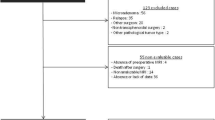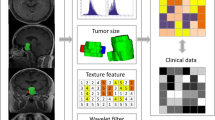Abstract
Objective
This study aimed to examine the reliability of existing Knosp grade (KG) and modified KG for cavernous sinus invasion (CSI).
Methods
A thorough search of literature from 1993 to 2020 in six databases was performed. Studies that reported the intraoperative confirmation of CSI using KG and/or modified KG were included. The pooled estimates were calculated by meta-analysis with a bivariate mixed-effect model and the assessment of heterogeneity with I2 statistic.
Results
The final search yielded 12 eligible studies, which enrolled 3006 patients assessed with KG and 1315 patients assessed with modified KG. The results of the area under the receiver operating characteristic curve showed the good discriminative abilities of grades 2–4 (0.90), 3–4 (0.86) and 3B–4 (0.91) in predicting CSI. Grade 3A showed a remarkably lower CSI rate (44% versus 81%) and incomplete resection rate (26% versus 52%) than grade 3B. Grades 0 and 1 showed a low CSI rate. CSI and incomplete resection rates in grade 2 (30% and 21%, respectively) were close to those in grade 3A.
Conclusions
Modifying the KG improved its prognostic role in CSI and gross total resection. However, these grading systems cannot be used as the group standard for invasive and non-invasive pituitary adenomas (PAs) because of the weak reliability of the scale’s middle grades (grades 2 and 3A). Authors of future PA studies should consider reporting KG as high (grades 3B and 4), medium (grades 2 and 3A) and low (grades 0 and 1) to optimise the application of the scale.



Similar content being viewed by others
References
Micko A, Oberndorfer J, Weninger WJ, Vila G, Hoftberger R, Wolfsberger S et al (2019) Challenging Knosp high-grade pituitary adenomas. J Neurosurg 31:1–8. https://doi.org/10.3171/2019.3.JNS19367
Raverot G, Burman P, McCormack A, Heaney A, Petersenn S, Popovic V et al (2018) European Society of Endocrinology Clinical Practice Guidelines for the management of aggressive pituitary tumours and carcinomas. Eur J Endocrinol 178(1):G1–Gg24. https://doi.org/10.1530/eje-17-0796
Zoli M, Milanese L, Bonfatti R, Sturiale C, Pasquini E, Frank G et al (2016) Cavernous sinus invasion by pituitary adenomas: role of endoscopic endonasal surgery. J Neurosurg Sci 60(4):485–494
Melmed S (2020) Pituitary-Tumor Endocrinopathies. N Engl J Med 382(10):937–950. https://doi.org/10.1056/NEJMra1810772
Knosp E, Steiner E, Kitz K, Matula C (1993) Pituitary adenomas with invasion of the cavernous sinus space: a magnetic resonance imaging classification compared with surgical findings. Neurosurgery 33(4):610–617. https://doi.org/10.1227/00006123-199310000-00008
Lamback EB, Guterres A, Barbosa MA, Lima CHA, Silva DA, Camacho A et al (2020) Cyclin A in nonfunctioning pituitary adenomas. Endocrine 70(2):380–387. https://doi.org/10.1007/s12020-020-02402-5
Kosugi K, Tamura R, Mase T, Tamura H, Jinzaki M, Yoshida K et al (2019) Relationship between pneumatization of lateral recess in the sphenoid sinus and removal of cavernous sinus invasion in pituitary adenomas by endoscopic endonasal surgery. Surg Neurol Int 10:222. https://doi.org/10.25259/sni_169_2019
Mooney MA, Hardesty DA, Sheehy JP, Bird R, Chapple K, White WL et al (2017) Interrater and intrarater reliability of the Knosp scale for pituitary adenoma grading. J Neurosurg 126(5):1714–1719. https://doi.org/10.3171/2016.3.Jns153044
Liu X, Ma L, Wang Z, Ye J, Liu X, Jiang G et al (2019) Expression and clinical significance of doublecortin (DCX) in pituitary adenoma. Bull Cancer 106(12):1080–1085. https://doi.org/10.1016/j.bulcan.2019.05.009
Li W, Zhang Y, Zhang M, Huang G, Zhang Q (2014) Wnt4 is overexpressed in human pituitary adenomas and is associated with tumor invasion. J Clin Neurosci 21(1):137–141. https://doi.org/10.1016/j.jocn.2013.04.034
Dallapiazza R, Bond AE, Grober Y, Louis RG, Payne SC, Oldfield EH et al (2014) Retrospective analysis of a concurrent series of microscopic versus endoscopic transsphenoidal surgeries for Knosp Grades 0–2 nonfunctioning pituitary macroadenomas at a single institution. J Neurosurg 121(3):511–517. https://doi.org/10.3171/2014.6.Jns131321
Micko AS, Wöhrer A, Wolfsberger S, Knosp E (2015) Invasion of the cavernous sinus space in pituitary adenomas: endoscopic verification and its correlation with an MRI-based classification. J Neurosurg 122(4):803–811. https://doi.org/10.3171/2014.12.Jns141083
Yamada S, Fukuhara N, Horiguchi K, Yamaguchi-Okada M, Nishioka H, Takeshita A et al (2014) Clinicopathological characteristics and therapeutic outcomes in thyrotropin-secreting pituitary adenomas: a single-center study of 90 cases. J Neurosurg 121(6):1462–1473. https://doi.org/10.3171/2014.7.Jns1471
Whiting PF, Rutjes AW, Westwood ME, Mallett S, Deeks JJ, Reitsma JB et al (2011) QUADAS-2: a revised tool for the quality assessment of diagnostic accuracy studies. Ann Intern Med 155(8):529–536. https://doi.org/10.7326/0003-4819-155-8-201110180-00009
Reitsma JB, Glas AS, Rutjes AW, Scholten RJ, Bossuyt PM, Zwinderman AH (2005) Bivariate analysis of sensitivity and specificity produces informative summary measures in diagnostic reviews. J Clin Epidemiol 58(10):982–990. https://doi.org/10.1016/j.jclinepi.2005.02.022
Vieira JO Jr, Cukiert A, Liberman B (2006) Evaluation of magnetic resonance imaging criteria for cavernous sinus invasion in patients with pituitary adenomas: logistic regression analysis and correlation with surgical findings. Surg Neurol 65(2):130–135. https://doi.org/10.1016/j.surneu.2005.05.021
Cao L, Wang S, Ma M, Zhong Q, H C (2012) Value of MRI characteristics of medial wall of cavernous sinus in preoperative assessment of invasive pituitary adenomas. Chin J Neurosurg 28(4):350–354. https://doi.org/10.3760/cma.j.issn.1001-2346.2012.04.009
Nishioka H, Fukuhara N, Horiguchi K, Yamada S (2014) Aggressive transsphenoidal resection of tumors invading the cavernous sinus in patients with acromegaly: predictive factors, strategies, and outcomes. J Neurosurg 121(3):505–510. https://doi.org/10.3171/2014.3.Jns132214
Paluzzi A, Fernandez-Miranda JC, Tonya Stefko S, Challinor S, Snyderman CH, Gardner PA (2014) Endoscopic endonasal approach for pituitary adenomas: a series of 555 patients. Pituitary 17(4):307–319. https://doi.org/10.1007/s11102-013-0502-4
Jiang C, Yan X, Wang C, Kang D, Lin Y, Zhangya L (2016) A study of preoperative MRI evaluation for cavernous sinus invasion by pituitary macroadenoma. J Fujian Med Univ 50(1):38–42
Lang M, Silva D, Dai L, Kshettry VR, Woodard TD, Sindwani R et al (2018) Superiority of constructive interference in steady-state MRI sequencing over T1-weighted MRI sequencing for evaluating cavernous sinus invasion by pituitary macroadenomas. J Neurosurg 1:1–8. https://doi.org/10.3171/2017.9.Jns171699
Buchy M, Lapras V, Rabilloud M (2019) Predicting early post-operative remission in pituitary adenomas: evaluation of the modified knosp classification. Pituitary 22(5):467–475. https://doi.org/10.1007/s11102-019-00976-6
Xueyou X, Zhiren W (2019) Performance of Knosp grade for cavernous sinus invasion of Cushing’s disease. Natl Med J China 99(5):388–390. https://doi.org/10.3760/cma.j.issn.0376-2491.2019.05.014
Xinyu W, Xiaochuan H, Yue B, Yibao W (2019) The significance of Knosp classification and cavernous sinus division in endoscopic transnasal surgery for invasive pituitary adenomas. Chin J Contemp Neurol Neurosurg 19(3):170–176. https://doi.org/10.3969/j.issn.1672-6731.2019.03.006
Dhandapani S, Singh H, Negm HM, Cohen S, Anand VK, Schwartz TH (2016) Cavernous sinus invasion in pituitary adenomas: systematic review and pooled data meta-analysis of radiologic criteria and comparison of endoscopic and microscopic surgery. World Neurosurg 96:36–46. https://doi.org/10.1016/j.wneu.2016.08.088
Author information
Authors and Affiliations
Corresponding author
Ethics declarations
Conflict of interest
The authors declare that they have no conflicts of interest.
Ethical Approval
This is a meta-analysis based on observational studies.
Informed Consent
Informed consent from patients and ethical approval for this type of study are not required.
Additional information
Publisher’s note
Springer Nature remains neutral with regard to jurisdictional claims in published maps and institutional affiliations.
Electronic supplementary material
Below is the link to the electronic supplementary material.
Rights and permissions
About this article
Cite this article
Fang, Y., Pei, Z., Chen, H. et al. Diagnostic value of Knosp grade and modified Knosp grade for cavernous sinus invasion in pituitary adenomas: a systematic review and meta‐analysis. Pituitary 24, 457–464 (2021). https://doi.org/10.1007/s11102-020-01122-3
Accepted:
Published:
Issue Date:
DOI: https://doi.org/10.1007/s11102-020-01122-3




